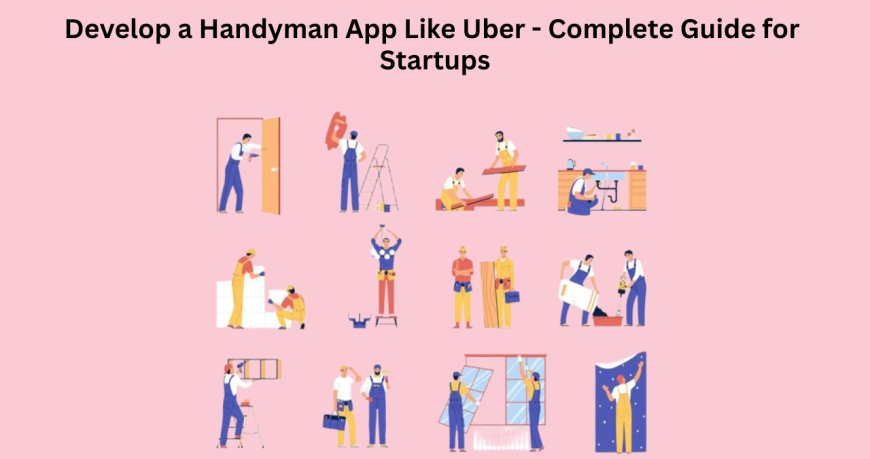Develop a Handyman App Like Uber - Complete Guide for Startups
Learn how to develop a handyman app like Uber with key features, cost insights, and expert tips to build a scalable, on-demand home service platform.

The on-demand economy is booming, and one of the most promising sectors in this space is home services. People are no longer flipping through phone directories or waiting days for help with tasks like plumbing, furniture assembly, or electrical work. Instead, they’re tapping into apps that bring a handyman to their door in just a few clicks.
If you're a startup founder or entrepreneur, now is the perfect time to develop a handyman app like Uber. In this blog, we’ll take you through a complete guide on how to build a successful on-demand handyman app from scratch, what features to include, how to earn revenue, and the challenges to prepare for.
Why Invest in a Handyman App Like Uber?
The handyman service market has witnessed rapid growth in recent years. Busy professionals and even seniors increasingly prefer digital solutions to get home repairs done. A handyman app not only makes service booking easy for customers but also helps professionals find consistent jobs.
The Uber-like model works great in this industry because:
- It enables real-time service booking.
- Customers can track professionals live.
- Payments and reviews are seamless.
- Service providers get instant job opportunities.
These benefits make it a lucrative business idea for startups with the right approach.
Step 1: Understand the Handyman Service App Model
A handyman service app typically operates on a two-sided marketplace model. It connects users (those who need services) with service providers (handymen, technicians, etc.) via a mobile or web platform.
The key components include:
- A customer app
- A handyman app
- An admin panel (for business control and monitoring)
You can offer various services such as plumbing, electrical work, carpentry, appliance repairs, painting, and cleaning. Having a wide range of categories improves user retention and app engagement.
Step 2: Plan Your Features Carefully
Your app’s success will largely depend on its features. A well-designed, intuitive app makes the booking process smooth and builds user trust.
Must-Have Features for Customers:
- Easy Sign-Up/Login: Email, mobile number, or social media options.
- Service Categories: Clear list of all handyman services.
- Booking Interface: Simple form to select service, date, and time.
- Real-Time Tracking: See where the handyman is after booking.
- In-App Payments: Secure options like cards, wallets, UPI.
- Ratings & Reviews: For feedback and trust-building.
- Chat Support: In-app messaging or customer care support.
Must-Have Features for Handyman:
- Profile Management: Add experience, skills, service area, availability.
- Job Notifications: Alert when a new service request is nearby.
- Accept/Reject Option: For flexibility in scheduling.
- Earnings Dashboard: Daily/weekly income insights.
- In-App Chat: To discuss job details with the client.
- Navigation & Directions: GPS-based tools to reach the service location.
Read More: Kickstart Your Handyman App like Uber: Feature & Cost
Admin Panel Features:
- User & Service Provider Management
- Order History & Status Tracking
- Analytics Dashboard
- Payment and Commission Settings
- Promo Code Management
- Reports & Reviews Management
Step 3: Choose the Right Technology Stack
If you’re building a handyman service app from scratch, your tech choices will impact the performance and scalability.
- Frontend (Customer/Provider App): React Native, Flutter
- Backend: Node.js, Python, or PHP
- Database: MongoDB, MySQL
- Push Notifications: Firebase, OneSignal
- Maps & Tracking: Google Maps API
- Payment Gateway: Stripe, Razorpay, PayPal
Make sure your tech stack supports scalability as your user base grows.
Step 4: Decide on Your Revenue Model
Your handyman app should be more than functional—it should generate profit. Here are the most popular monetization models:
- Commission Per Booking: You earn a percentage from each transaction.
- Subscription Plans: Service providers pay monthly/quarterly fees to get more visibility or access to job requests.
- Ad Listings: Promote specific handymen or services for a fee.
- Surge Pricing: Apply higher charges during peak hours or high-demand days.
Start with one or two models and expand as your app gains traction.
Step 5: Build an MVP (Minimum Viable Product)
Launching a full-featured app from day one is expensive and risky. Instead, go for an MVP that includes the essential features. This lets you test the market, gather feedback, and improve the product based on real-world use.
An MVP for a handyman app like Uber might include:
- User and service provider login
- Service listing
- Booking system
- Payment integration
- Ratings & reviews
Once your MVP is stable and you understand your audience, you can scale up.

Step 6: Focus on UX/UI Design
User experience can make or break your app. Invest in clean, user-friendly design that makes navigation effortless.
Some tips:
- Keep the interface clutter-free
- Use easy-to-read fonts and icons
- Ensure a smooth booking flow
- Make load times fast (under 3 seconds)
Don’t forget to optimize the design for both Android and iOS devices.
Step 7: Partner with Skilled Handymen
Your app’s value depends on the quality of service it delivers. Start by onboarding certified and experienced handymen. You can verify their background, collect identification documents, and train them on how to use the app.
Offering initial incentives (like lower commissions) can attract good service providers.
Step 8: Market Your App Effectively
Even the best app won’t succeed without proper marketing. Use a mix of online and offline strategies to reach both users and handymen.
Here’s how:
- SEO: Optimize your website for local searches (e.g., “handyman app in Boston”).
- Social Media Ads: Target homeowners, renters, and service professionals.
- Referral Programs: Reward users and providers for bringing new members.
- Partnerships: Collaborate with local hardware stores or real estate agencies.
Offline strategies like flyers, community bulletin boards, and local radio ads can also help.
Step 9: Track Performance & Optimize
After your app launches, track how it performs. Monitor metrics like:
- Daily active users
- Booking success rate
- Average ratings
- Most requested services
- Revenue and commissions
Use this data to improve your service offerings, remove friction points, and expand to new areas.
Challenges to Prepare For
While the handyman app industry offers great opportunities, there are also challenges:
- High Competition: You need a unique value proposition.
- Retaining Providers: Skilled professionals may jump to competitors.
- Customer Trust: Building credibility takes time.
- Technical Issues: Downtime or bugs can frustrate users.
Solving these proactively with the right tech team and support system will help you build a reliable brand.
Conclusion
Developing a handyman app like Uber is a smart move for startups aiming to tap into the booming on-demand economy. With thoughtful planning, the right features, and a clear monetization strategy, you can build a scalable and successful business. Most importantly, partner with a skilled clone app development company that understands your vision and can bring it to life with quality and efficiency. Your journey toward creating a convenient and modern home service platform starts today.
What's Your Reaction?
 Like
0
Like
0
 Dislike
0
Dislike
0
 Love
0
Love
0
 Funny
0
Funny
0
 Angry
0
Angry
0
 Sad
0
Sad
0
 Wow
0
Wow
0








































